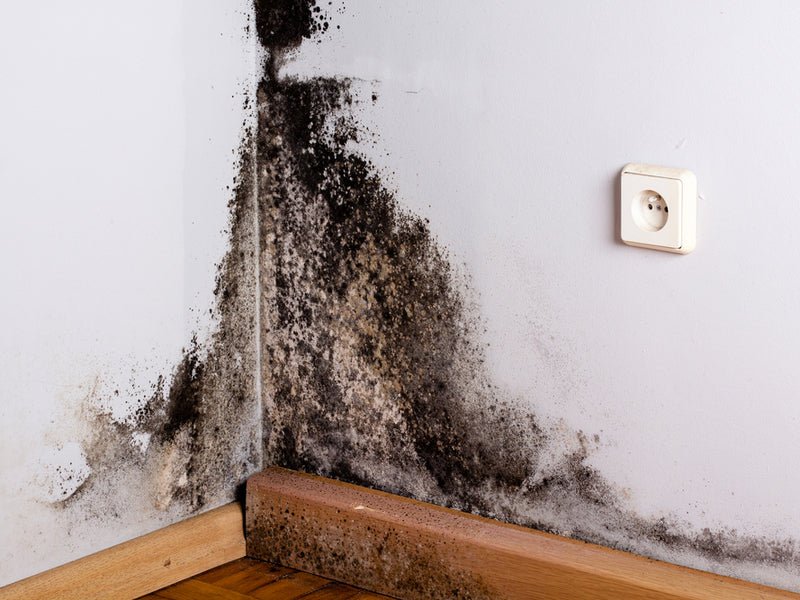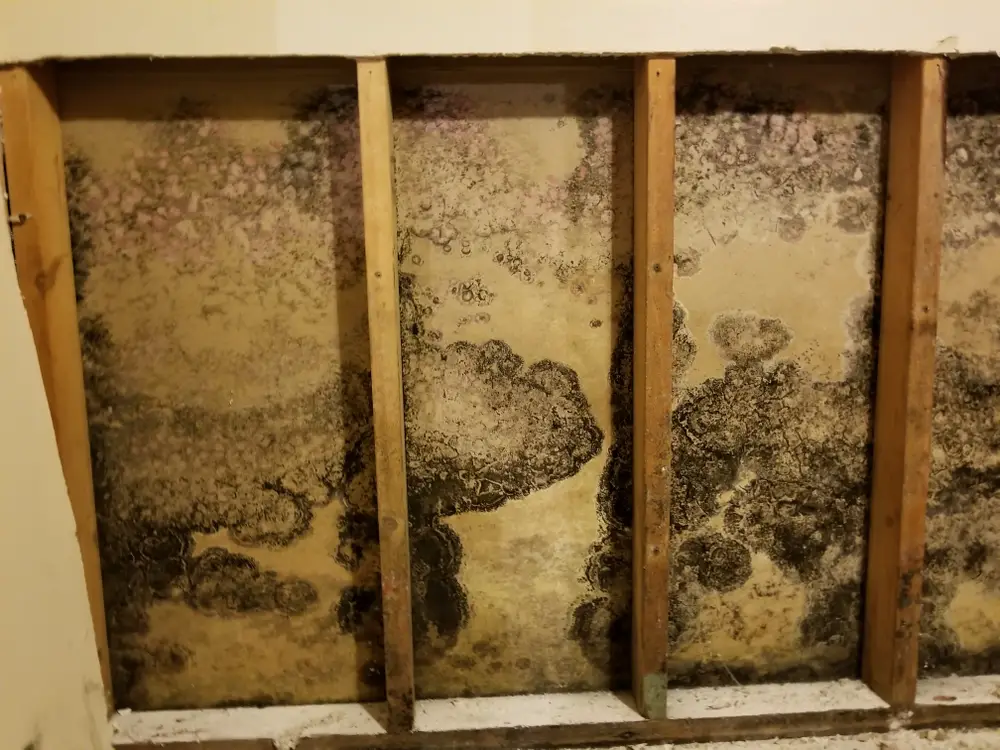Are you concerned about the possibility of black mold infestation on your drywall? It’s important to be aware of the signs that indicate the presence of this potentially harmful substance. This article will give you a brief overview of the common signs to look out for, helping you to identify any black mold infestation on your drywall and take appropriate action to address the issue. From unusual odors to visible discoloration, knowing what to look for can help you ensure the health and safety of your home.

Visible Signs
Discoloration
One of the most common signs of black mold infestation on drywall is discoloration. You may notice dark patches or splotches on your walls, particularly in areas that are damp or prone to moisture. These patches can range in color from black to greenish-black, and they can spread if left untreated.
Stains
Black mold can leave behind stubborn stains on your drywall. These stains often appear as green or black streaks, and they can be difficult to remove. If you notice any unusual stains on your walls, especially in areas where moisture is present, it’s important to investigate the possibility of black mold infestation.
Fuzzy Growth
Another visible sign of a black mold infestation on drywall is the presence of fuzzy growth. Black mold has a distinctive appearance, with its dark color and soft, fuzzy texture. If you notice any fuzzy patches or growths on your walls, it’s crucial to take action immediately to prevent further spread and potential health issues.
Peeling or Bubbling Paint
Black mold thrives in moist environments, and this can cause the paint on your walls to peel or bubble. If you notice any unusual changes in the paint, such as peeling or bubbling, it could be a sign of a black mold problem. It’s important to address this issue promptly to prevent further damage to your walls and potential health risks.
Warped or Bulging Drywall
Black mold can cause drywall to warp or bulge, especially if the infestation is severe. If you notice any structural changes in your drywall, such as warping or bulging, it’s crucial to investigate the possibility of a black mold infestation. These changes can indicate that the mold has spread behind the walls and requires immediate attention.
Odor
Musty Smell
One of the most noticeable signs of a black mold infestation is a musty smell. If you detect a strong, unpleasant odor in your home, particularly in areas with high humidity or moisture, it could be a sign of black mold. This musty odor is caused by the volatile organic compounds (VOCs) released by the mold and should not be ignored.
Earthy or Damp Odor
In addition to the musty smell, black mold infestations can also emit an earthy or damp odor. This odor can be especially strong in basements, bathrooms, or any other areas that are prone to moisture. If you notice a persistent earthy or damp smell, it’s essential to investigate for black mold and take appropriate action to eliminate it.
Health Symptoms
Respiratory Issues
Exposure to black mold can trigger respiratory problems, such as coughing, wheezing, and difficulty breathing. If you or your family members experience any unexplained respiratory issues, it’s important to consider the possibility of a black mold infestation. Mold spores can become airborne and irritate the respiratory system, causing these symptoms to occur.
Allergic Reactions
Black mold is a common allergen and can cause allergic reactions in susceptible individuals. These reactions may include sneezing, runny nose, itchy or watery eyes, and nasal congestion. If you notice an increase in these allergic symptoms, particularly when spending time in a specific area of your home, it’s crucial to investigate for black mold infestation.
Skin Irritations
In some cases, black mold exposure can lead to skin irritations. These can range from minor rashes and itchiness to more severe reactions such as dermatitis or hives. If you or your family members develop unexplained skin irritations that do not improve with topical treatments, it’s important to consider the possibility of a black mold infestation.
Headaches and Dizziness
Black mold exposure can also cause headaches and dizziness in some individuals. These symptoms may occur when spending time in areas with high black mold concentrations. If you experience frequent headaches or dizziness that cannot be attributed to other causes, it’s crucial to investigate for black mold infestation and take appropriate measures to address the issue.
Water Damage
Leaking Pipes
Leaking pipes can provide the moisture necessary for black mold to grow on your drywall. If you notice any signs of water damage, such as wet spots, water stains, or dripping, it’s important to address the issue promptly to prevent black mold infestation. Fixing any leaking pipes and drying the affected areas thoroughly is essential to prevent mold growth.
Roof Leaks
Roof leaks can also contribute to black mold infestation on your drywall. If you notice water stains or dampness on your ceiling or upper walls, it’s crucial to investigate for roof leaks and address them promptly. Water intrusion from the roof can create the perfect environment for black mold to thrive and spread.
Poor Ventilation
Lack of proper ventilation in your home can lead to high humidity levels, which can encourage black mold growth on your drywall. Areas such as bathrooms, kitchens, and basements are particularly susceptible to poor ventilation. Installing exhaust fans, improving air circulation, and ensuring adequate ventilation in these areas can help prevent black mold infestation.

High Humidity
Condensation
Condensation on windows, walls, or other surfaces is a clear indicator of high humidity levels in your home. Excessive moisture in the air can promote black mold growth on your drywall. If you notice condensation regularly forming in your home, particularly in colder months, it’s important to address the humidity issue to prevent black mold infestation.
Humid Climate
Living in a humid climate can make your home more vulnerable to black mold infestation. High humidity levels in the air provide the ideal conditions for mold to grow and spread. If you reside in a humid climate, it’s essential to take extra precautions to control moisture levels in your home, such as using dehumidifiers and ensuring proper ventilation.
Previous Mold Infestation
History of Mold Growth
If you have previously experienced a mold infestation in your home, particularly on your drywall, it increases the likelihood of future black mold problems. Mold spores can remain dormant and reappear under the right conditions. It’s important to be vigilant and regularly monitor your drywall for any signs of black mold, especially if there has been a history of mold growth.
Incomplete Remediation
If a previous mold infestation was not thoroughly remediated, it can leave behind residual mold spores that can lead to future black mold problems. Inadequate removal of mold-contaminated materials or failure to address the underlying cause of mold growth can result in recurring issues. It’s crucial to ensure that any previous mold infestation has been properly remediated to prevent further problems.

Efflorescence
White Powdery Substance
Efflorescence is a white, powdery substance that can appear on the surface of your drywall. While not always a sign of black mold, it can indicate high moisture levels in the wall. Efflorescence is caused by water-soluble salts that are present in building materials and get pushed to the surface by moisture. It’s essential to address the underlying moisture issue to prevent black mold growth.
Testing
Mold Testing Kits
Mold testing kits are available for individuals who want to identify the presence of black mold on their drywall. These kits usually include swabs or tape samples that can be collected and sent to a laboratory for analysis. However, it’s important to note that DIY mold testing kits may not be as accurate as professional inspection and may not identify the full extent of mold infestation.
Professional Inspection
A professional mold inspection is the most reliable way to determine if your drywall is infested with black mold. Certified mold inspectors have the expertise and tools to identify, assess, and provide recommendations for remediation. They can perform a detailed inspection of your drywall, air quality testing, and moisture measurements to accurately assess the extent of the black mold infestation.

Prevention
Maintain Low Humidity Levels
One of the most effective ways to prevent black mold growth on your drywall is to maintain low humidity levels in your home. Use dehumidifiers, especially in areas prone to moisture, such as basements and bathrooms. Keep the relative humidity below 50% to create an environment that is less favorable for black mold to thrive.
Proper Ventilation
Good ventilation is essential for preventing black mold growth. Ensure that your home has proper ventilation in areas such as bathrooms, kitchens, and laundry rooms. Use exhaust fans or open windows to allow moisture-laden air to escape. A well-ventilated home helps to reduce humidity levels and minimize the risk of black mold infestation.
Fix Water Leaks Promptly
Promptly addressing any water leaks in your home is crucial for preventing black mold growth. Inspect your plumbing system regularly and fix any leaks immediately. Check for signs of water damage, such as wet spots, stains, or dripping water. Timely repairs and addressing the source of water intrusion can help prevent black mold infestation.
Use Mold-Resistant Drywall
Using mold-resistant drywall can provide an extra layer of protection against black mold growth. Mold-resistant drywall has a special coating or additive that inhibits mold growth even in high-moisture areas. Consider using mold-resistant drywall in bathrooms, kitchens, or any other areas of your home that are prone to moisture.
Remove Mold-Damaged Materials
If you have experienced a black mold infestation on your drywall, it’s important to remove and dispose of any mold-damaged materials properly. Mold can penetrate porous materials, and simply cleaning the surface may not eliminate all traces of mold. Consult with a professional mold remediation service to safely remove and dispose of mold-contaminated materials.
Professional Remediation
Contracting Certified Mold Removal Services
In cases of severe black mold infestation on drywall, it is advisable to seek professional mold removal services. Certified mold remediation professionals have the necessary expertise, equipment, and safety protocols to effectively handle the situation. They can assess the extent of the infestation, contain the affected areas, and safely remove the mold, ensuring thorough remediation.
Ensuring Containment and Safety
During the mold removal process, it is crucial to ensure proper containment to prevent the spread of mold spores throughout your home. Certified mold removal services use techniques such as negative air pressure and physical barriers to contain the affected areas, minimizing the risk of cross-contamination. They also follow strict safety protocols to protect themselves and your property during the remediation process.
Proper Disposal of Affected Materials
Disposing of mold-contaminated materials properly is essential to prevent further spread of mold spores. Professional mold remediation services have the knowledge and resources to safely handle and dispose of mold-damaged materials. They follow industry guidelines for hazardous waste disposal to minimize the environmental impact and ensure proper containment of the mold-infested materials.
In conclusion, recognizing the signs of black mold infestation on drywall is crucial for maintaining a healthy indoor environment. By paying attention to visible signs, odor, health symptoms, water damage, high humidity, previous mold infestations, efflorescence, and seeking professional testing and remediation when needed, you can effectively prevent and address black mold issues. Taking proactive measures, such as maintaining low humidity levels, proper ventilation, promptly fixing water leaks, using mold-resistant drywall, and removing mold-damaged materials, can help you create a mold-free home and ensure the well-being of you and your family.
